#White Millet
Explore tagged Tumblr posts
Text
youtube
#Worldwide Birds#Birds Seeds#Foxtail#White Millet#Black Millet#Pearl Millet#Striped Sun Flower#Japanese Millet#Red Millet#Hemp#Canary#Yellow Millet#White Sun Flower#Proso Millet#Sesame#Nigar-seed#Barley#Polao Rice#Black Sun Flower#Buck Wheat#Wholesale Market#Market Update#Seed Market#Birds Market#Youtube
0 notes
Text

GF Blueberry Cobbler with Oat Biscuits
#gluten free#blueberry#biscuits#oat#bread#baking#berries#fruit#recipe#oatmeal#summer#sweet white rice flour#millet flour#greek yogurt#yogurt#bojongourmet
217 notes
·
View notes
Text
I met the girls and instantly liked the girls. Of course I liked the girls. A girl is better than a feast.
Lydia Millet, from ‘Snow White, Rose Red’ in the collection My Mother She Killed Me, My Father He Ate Me
4 notes
·
View notes
Photo

Hommage aux peintres de l’école de Barbizon©FrançoiseLarouge2023
#photographers on tumblr#Barbizon#barbizon school#ecoledebarbizon#foret#bnw landscape#nature#photographie noir et blanc#noir et blanc#Black and White#tree#arbres#Millet#jean françois millet#peinture#peintre#histoire de l art#paysage#France#Fra#Françoise Larouge
25 notes
·
View notes
Text

The Truth about White Rice: Hidden Dangers of Processed Carbohydrates
White Rice might perhaps be the staple preparation item seen in any number of Indian recipes. It has been a staple for thousands of years and is integrated into a host of traditional dishes ranging from biryani to idli. Boiled with a fluffy texture, it may seem paler than other things but brings unmatched to so many recipes. However, in the case of White Rice, the refined nature promises secret dangers that should be negotiated because of the rich food heritage of India. This blog explores the deception of White Rice and highlights the reasons for embracing better alternatives to uplift diet and health quality.
The Refining Process and Its Impact
White Rice is preferred in Indian cooking because of the soft texture of the cooked Rice which helps to balance rich curries and stews. Of course, this also means that during the refining process, the bran and germ of the Rice grain are stripped away, leaving the nutrients and fiber behind. The only thing left is the starchy endosperm of the Rice grain, which has far fewer health benefits to offer.
Nutrient Removal
Rice loses a good amount of nutritional value through refining. Here's what's lost:
- Fiber: Fiber helps to prevent constipation and maintain stable blood sugar levels. It is used for digestive health.
- Vitamins: Some deficiencies found in White Rice include B vitamins, B1 or thiamine, B3 or niacin, and B6, which are used in energy metabolisms and total well-being.
- Minerals: Some of the important minerals in diets are lost during the refining process, such as iron, magnesium, and zinc.
Notably, many of these nutrients are replenished by enrichment but are far from comparable to the integral nutritional value found with brown Rice or other whole grains.

Health Risks of White Rice
1. High Glycemic Index
The high GI in White Rice forces the glycaemic activity and rapid spiking of blood sugar levels, eventually leading to insulin resistance, thereby increasing the risk of type 2 diabetes area of tremendous concern in India with each passing year, with cases increasingly ascribed to lifestyle and dietary habits.
Comparison: Traditional Indian grains like Brown Rice and Millets have a low GI; which hence keeps the blood sugar level more balanced.
2. Weight Management Issues
Weight gain and obesity, which are increasingly of concern among India's population today, could be linked with high-GI foods like White Rice that cause hunger and overeating. The high fiber content in more grain types would reduce hunger and help retain their weight control.
White Rice in Indian Heritage
Indian heritage does not have any other place but a revered one for White Rice. It is used to prepare:
Any kind of Biryani: Steamed fragrant Rice with spices, meat, and sometimes vegetables.
Idli and Dosa: Steamed fermented Rice cakes and crepes from Rice and urad dal or black gram respectively.
Pulao: Rice preparation cooked with aromatic spices and vegetables or meat based on the choice.
As these cuisines constitute an impeccable portion of Indian culture, giving way to healthier options does not degrade the original staple foods in any way.

Healthier Variants Dominant in the Indian Tradition
1. Brown Rice
Brown Rice is a whole grain that includes bran and germ, thereby increasing the fiber content and also vitamins and minerals. It is much healthier than White Rice and can easily be a substitute for most traditional recipes.
Usage: Brown Rice Biryani or Pulao may be a wholesome alternative to traditional recipes.
2. Millets
Indians have been consuming these super grains such as Foxtail millet, Finger millet, and Barnyard millet for generations. Essential minerals, fiber, and protein are rich in Millets.
Usage: Millets offer a wholesome and nutritious substitute for your regular Dosa, Khichidi and Upma.
3. Quinoa
Tiny Quinoa is a nutritious grain that is becoming more popular because of its high protein content and low GI, although not of Indian origin. It can be included in Indian dishes to improve health.
Usage: Quinoa can be used as a substitute for Rice in biryani or pulao or added to salads for that protein boost.
Healthier Grains in Traditional Dishes
There's no limit to the flavours of the traditional when making healthier grains. Here's how you can incorporate alternatives:
1. Begin Step-Wise: Mix Brown Rice with white Rice in your recipes. Gradually increase the percentage of brown Rice over time.
2. Experiment with Flavours: Spice up Brown Rice with flavouring herbs to make it all the more presentable in your recipe dishes.
3. Breathe New Life into Traditional Recipes: Replace White Rice with Brown Rice, Millets, or Quinoa while preparing your favourite traditional recipes and breathe a healthier twist to these old recipes.
Conclusion: Rephrasing White Rice
White Rice itself has a deceitful story. Its highly refined nature has decreased its nutritional value and is proven to contribute to many health problems. In consequence, by learning about the negative impact White Rice has on you and healthier Indian-tradition-based alternatives, you can modify your diet and improve your well-being.
The incorporation of whole grains, whether Brown Rice, Millets, or Barley, besides a healthier lifestyle, does justice to India's rich culinary heritage. Adapt to these changes, and you'll enjoy traditional flavours with healthy food on your table.
0 notes
Text
Inside PM Narendra Modi's state dinner menu: Millets, risotto and more
Around 400 guests have been invited to the State Dinner, which is being hosted by US President Joe Biden and First Lady Jill Biden for Prime Minister Narendra Modi at the White House today. As per news agency reports, a delicious vegetarian dinner menu has been prepared for the Prime Minister Reuters. However, there are no classic Gujarati dishes. The first course of the state dinner will include…

View On WordPress
#Dinner#dinner menu#menu#Millets#Modis#Narendra#narendra modi#PM Narendra Modi#Risotto#State#State Dinner at the White House#state dinner menu
0 notes
Text
Two of my long-term obsessions have just collided in an odd way.
I was watching "Wooster With a Wife" for the first time in about a decade and when I got to this scene, I gasped.

Because that little painting behind Jeeves looks like nothing much, but it used to be famous. It's called "Between Two Fires," and it was painted by the American master, Francis Davis Millet, in 1892.

It depicts a 17th-Century man sitting between two standing women, beneath a sprig of mistletoe. The piece itself was extremely popular in its time. It was often hung in houses, it was printed onto cigarette cases and biscuit tins. That's probably how it came to be hanging there on the wall of a pub. Somebody hung it there in 1900 and never took it down.
The thing that is particularly interesting to me, personally, about this painting is the artist who painted it. Frank Millet, born in Massachusetts in 1843, was once one of the most famous American artists in the world. He did murals in great cities across Europe and America, painted a portrait of his friend Mark Twain, was a personal friend of President William Howard Taft and John Singer Sargent. He was married and had children, but he was also known for having rather public relationships with other men, most notably the writer Charles Warren Stoddard. Their love letters are still in existence and some have been published in a biography of Stoddard.
Francis Davis Millet:
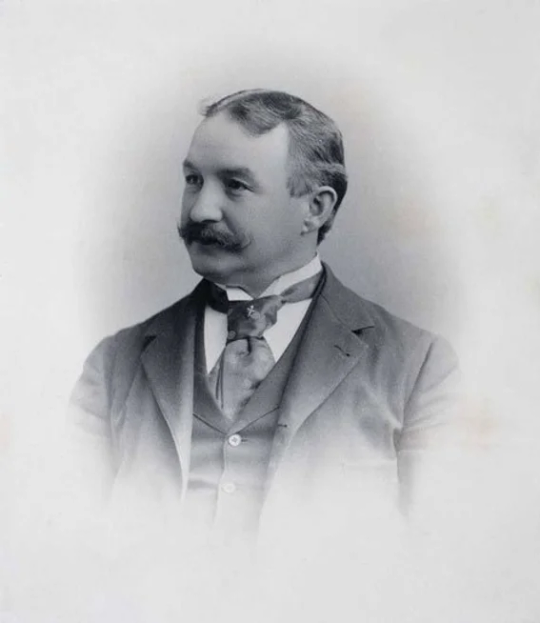
These days, the most famous thing about him is that he died on the Titanic, and as such he is the only confirmed queer victim of the Titanic sinking (obviously there must have been many others, but he's the only one with existing documentation that proves it). He happened to be traveling with a close friend whom he lived with, one Major Archibald Butt, who is often theorized to have been his partner at the time. We don't know much about their lives together, but we do know (from a letter Butt once wrote to his sister-in-law) that Millet wall-papered the inside of their house while Butt was away on a business trip. The wallpaper he chose was roses – so many roses, Butt said that he felt he was suffocating beneath a giant pile of them. It's rare to get any insight at all into the lives of men who may have been partners at that time, and I always rather loved this particular little story.
Major Archibald Butt:

Both men died in the sinking and they share a joint memorial fountain in Washington, DC. It's just behind the White House and was erected by their friends, who remembered them as being devoted to each other. Here's a little bit of information about the fountain from the National Park Service:
89 notes
·
View notes
Text
WIP Wednesday
I think it’s still a Wednesday somewhere… Thank you to @symphorine for the tag!
Context: the Man of Progress had been missing for months.
Nothing and no one impeded the Herald's progress until he arrived before the vault door. Viktor's eyes traced the grooves of the Talis insignia carved across its reinforced steel face.
At the exact same moment in the distance, scores upon scores of men and women and children were momentarily compelled to abandon what they had been doing and turn their faces to the horizon, as if they were sunflowers following the pull of an illusory celestial body, scanning and searching the fissures of Zaun, the cobbled streets of Piltover, and the Noxian war camps. Eyes upon eyes on stalks, seeing nothing and no one that Viktor was seeking.
The Herald did not sigh with disappointment, having left the notion of it behind, along with the disorder of human emotion. Instead, as he lowered his gaze, the arm-like appendage growing out his spine swivelled forward and, with a whirr and a click, unlocked its grip, revealing a spherical crystal of singular perfect blue.
(In the fissures, at the edge of an assemblage of white canvas tents, where children played and men and women dressed in white smiled as they gathered fruits, filtered water, and purified the air for those who came to them, those who resembled them before the Herald came to lay his healing hand on them—hurt and tired and hungry and longing to breathe free—a boy was running by the fields. His legs, which did not use to move, bore the mother-of-pearl inlays of Viktor's touch. Coming to a halt in the fertile soil, he raised his head to watch the wind sigh across the rows upon rows of drooping millet and listen to its soft, mournful sound.)
Tagging @huldraism and @42frogs . No pressure, of course!
20 notes
·
View notes
Text
White crowned sparrow loves millets
#photography#garden#nature#wildlife#cute#love#adorable#original art#artists on tumblr#animal video#bird video
32 notes
·
View notes
Note
*crawls under your desk while you’re working*
*I am counting white millet seeds, sorting them into piles based on some criteria you cannot detect. Partly because you're under the table.*
56 notes
·
View notes
Text

GF/DF Coconut Flour Banana Cake
#gluten free#coconut flour#dairy free#banana#cake#sheet cake#coconut#fruit#baking#recipe#sweet white rice flour#rice flour#millet flour#tapioca flour#tapioca#yogurt#cashew yogurt#nuts#bojongourmet
103 notes
·
View notes
Text
Genshin Character Names' Meanings Pt.2
Well, since we've got an announcement of our crane mom Cloud Retainer (or it's Xianyun now, I guess) and Gaming (no, not gaming Gaming, but like Ga Ming Gaming, you see), I thought it would be a great reason to sit down and make a compilation of all Liyue characters' names. Once again, I'll be glad if you tell me whether there are some mistakes, and have fun!
~~~~~~~~~~~~~~~~~~
Xiangling | From Chinese 香 (xiāng) meaning «Fragrant» and 菱 (líng) meaning «Water Caltrop» - Chinese Name
Xingqiu | From Chinese 行 (xíng) meaning «Carry Out», «Execute» or «Travel» and 秋 (qiū) meaning «Autumn» - Chinese Name
Chongyun | From Chinese 重 (chóng) meaning «Layer» and 雲, 云 (yún) meaning «Cloud» - Chinese Name
Hu Tao | Hu (胡, her surname) can mean «Doing things out of order or recklessly»; it's also present in «Butterfly» (蝴) and Tao (桃) is «Peach Tree» in Chinese, associated with longevity, immortality, and a sacred object - Chinese Surname and Name
Qiqi | From 七 (qī) meaning «Seven» - Chinese Name
Baizhu | From Chinese 白 (bái) meaning «White», «Pure» and 朮, 术 (zhú) meaning «Glutinous Millet» - Chinese Name
Yaoyao | From 瑶 (yáo) meaning «Jade», «Precious Stone» or «Beautiful» - Chinese Name
Yanfei | From Chinese 烟 (yàn) meaning «Smoke», «Vapor» and 绯 (fēi) which is for «Crimson», «Scarlet» - Chinese Name
Yelan | Literally «Night Orchid» in Chinese
Beidou | Named after the Big Dipper asterism, which is known in Chinese as 北斗 (Běidǒu). The name literally means «Northern Dipper». Interesting how it is also referred to as 北斗七星 (Běidǒu Qīxīng), lit. "Seven Stars of the Big Dipper" in Chinese. The North Star, Polaris, is located within this asterism and is used by sailors to navigate at sea. Yes, the name of the organization Qixing also consists of the same hieroglyphs, and the titles of the members of the Qixing are the same as the Chinese names for the stars in the Big Dipper
Xinyan | From 辛 (xīn) which is «Spicy» and 焱 (yàn) meaning «Fire», «Flame» - Chinese Name
Yun Jin | Yun (云) means «Cloud», and Jin (堇) means «Violet (plant)» - Chinese Surname and Name
Gaming | From 嘉 (jiā) «Praise», «Joyful» or «Auspicious» and 明 (míng) meaning «Bright», «Clear-sighted» or «Honest» - Chinese Name
Xiao | 魈 (Xiāo), which derived from a chinese legend "魑魅魍魉” in which there is a group of demons. although its mainly four demons
Alatus | Literally «Winged» in Latin
Shenhe | Most likely from 申 (shēn) meaning «State» and 鹤 (hè) meaning «Crane» - Chinese Name
Xianyun | 闲云 (xián yún), comes from a four word idiom 闲云野鹤 - «Drifting clouds and wild crane» It means people who are footloose and fancy-free
Ganyu | From Chinese 甘 (gān) meaning «Sweet» and 雨 (yǔ) meaning «Rain» - Chinese Name
Keqing | From 刻 (kè) «To Carve» and «Clear/Sunny» (qíng) - Chinese Name
Ningguang | Literally «Frozen Light» or «Concentrated Light» in Chinese
Zhongli | 钟 (zhōng) translates to clock and 離, 离 (lí) - «To leave», yet together they form 送钟 (sòng zhōng /song jong), which sounds exactly like the Chinese words for «Attending a funeral ritual» (送终 -sòng zhōng) and thus it is bad luck to gift clocks or watches - Chinese Name (and an interesting game of words)
Morax | Comes from Duke and Governor Morax, the 21st of Goetia Demons
Ping | 萍 (píng), means «Tender», «Natural» and «Friendly» - Chinese Name
Guizhong | From Chinese 歸, 归 (guī) meaning «To return» and 終, 终 (zhōng) meaning «To end» - Chinese Name
Osial | May be a portmanteau of Ose, the 57th of Goetia Demons
Beisht | Is likely derived from the Beisht Kione Dhoo (Manx: "Beast With the Black Head"), a creature from Isle of Man folklore, where "Beisht" means «Beast» or «Worm» in Manx.
Marchosias | Comes from Marquis Marchosias, the 35th of Goetia Demons
Havria | Could possibly be a form of Havres, another name of the 64th of Goetia Demons, Duke Flauros.
~~~~~~~~~~~~~~~~~~
Phew, that was probably the hardest one. There is still Inazuma up ahead, yet I at least have some knowledge in Japanese, while with Chinese names I had to look up every single one (I mean, I will double-check Inazuman names of course, it's just that I'm more sure about the meanings of some of them).
'Till next time!
#xiangling#genshin impact xingqiu#xingqiu#genshin impact chongyun#chongyun#genshin impact#genshin impact hu tao#hu tao#genshin impact qiqi#qiqi#genshin impact baizhu#baizhu#genshin impact yaoyao#yaoyao#genshin impact xinyan#xinyan#genshin impact yanfei#yanfei#genshin impact yelan#yelan#genshin impact beidou#beidou#genshin impact yun jin#yun jin#genshin impact xiao#xiao#genshin impact shenhe#shenhe#genshin impact ganyu#genshin impact liyue
87 notes
·
View notes
Text

Vincent van Gogh ֍ The Sheep Shearer (after Millet) (1889)
Van Gogh painted this sheep shearer 'in a range from lilac to yellow'. This is how he described it to his brother Theo from the asylum in Saint-Rémy, where he was staying because of his poor mental state. Vincent regained his self-confidence by copying works of art by other painters. In doing so, he worked from black-and-white prints, the depiction of which he copied fairly accurately. But he came up with the colors himself.
For this painting, he used a small woodcut as an example. It was part of the ten-part series The Work in the Field after paintings by Jean-François Millet (1814-1875). Vincent wrote: 'Now that I don't have any models, it ensures that I don't lose sight of the figure.'
#vincent van gogh#van gogh#loving vincent#the sheep shearer (after millet)#painting#art#gallery#jean-françois millet
23 notes
·
View notes
Text
Never going to shut up about how awesome this gf sandwich bread is, THIS SHIT IS TASTY it doesn't crumble too much, it isn't too dry, and it's not like eating an old dish sponge! (Believe me gluten-people, it's traumatizing out there in the gf bread world)
If you're not allergic to gluten I'd reccomend saving this anyways bc it's super easy and if you make friends with someone gf they will love you forever if you make this and might consider marrying you (I don't make the rules I'm just the messenger)
Anyways here's the recipe I'm no gatekeeper<3
Gf loaf/sandwich bread
Ingredients:
Proofing the Yeast:
- ¼ cup warm water (about 100F/37C)
- 1-2 tbs honey (I do 1 bc I like savory taste. Idk if it's actually different)
- 5-7 grams active yeast
Dry:
- 260 g rice flour (white or brown is fine) (not starch, that'll change the texture) (I do plan on trying it some time but haven't yet so) (will update if I remember to ig)
- 80 g tapioca starch
- 60 g millet flour (can substitute with oat flour but millet crisps better for toast n grilled cheese)
- 5-8 grams xanthan gum
- 1/2 tsp salt
Wet:
- 3 eggs room temperature
- 1 tbs apple cider vinegar
- 1 ¼ cup water (about 100F/37C)
- ¼ cup butter
Equipment:
Bread vessel for baking it in (pan, ramekins, muffin, whatever honestly)
Baking scale
Hand Mixer
Bowl and measuring cups
Oven (typically)
Instructions:
1. Combine ¼ cup warm water (I microwave it for 20 seconds) with honey and stir well. Mix in the yeast and let sit for 10-30 minutes to proof.
2. Combine all dry ingredients in large mixing bowl and mix.
3. Add yeast mixture, (this is where I heat the water and melt the butter in the same bowl bc the yeast prefers warmth) 1 ¼ cups warm water, ¼ cup butter, eggs, and apple cider vinegar to the dry ingredients.
4. Using a hand or stand mixer, beat mixture for 1-2 minutes. It'll be a bit thicker than pancake batter but not much.
5. Scoop bread batter into an oiled pan right away.
6. Place bread dough in a warm location to rise for approximately 1 hour. Can wait longer if it's not very warm.
7. Preheat oven 350 deg F (180 C).
8. Bake uncovered for 20-30 mins depending on vessel size (muffins is 20) stab with a toothpick to know if it's done, you shouldn't have more than a tiny crumb on it.
9. Let cool completely before slicing or moving containers. Ta da! Bread 👍👍
Notes:
* Depending on your environment, the dough may take longer than an hour to rise. In this case, simply monitor how high the dough has risen in the pan until it's puffed taller than the pan/ramekin/vessel
* Keeps well in a sealed bag or container on the counter for a couple of days, in the refrigerator for like two weeks. (I never use it that slowly lol) If you refrigerate the bread, the slices taste better toasted.
* You can probably freeze it if you take a long time to use bread. I've frozen other breads just fine, I haven't tried this but I imagine it's not too different
* If you're thinking about using cup measurements for the dry ingredients instead of weight, don't. Bread is a fancy girl and doesn't like that common guestimation stuff. If the baking scale scares you, it's ok! It just tells you what number you have and you can hit reset between ingredients to avoid excessive math I didn't do written math over baking what be brave! And bake! I believe in you<3
#bread#gluten free#gluten free bread#gluten free bread recipe#recipe#the people need to know!#🌇#☁️#a wild fabian appears#anyways I'm so normal abt my breakfast sandwich just now#didn't uh#spend half an hour writing and editing this when I got shit to do........#<3#love and peace! ✌️
12 notes
·
View notes
Text
THIS DAY IN GAY HISTORY
based on: The White Crane Institute's 'Gay Wisdom', Gay Birthdays, Gay For Today, Famous GLBT, glbt-Gay Encylopedia, Today in Gay History, Wikipedia, and more … January 12


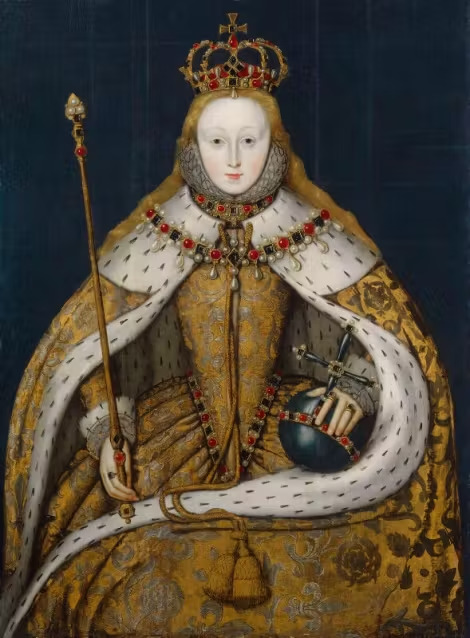
1564 – Queen Elizabeth I reinstates the buggery law in England which makes sodomy illegal.


1706 – Pennsylvania eliminates the castration penalty from its sodomy law.

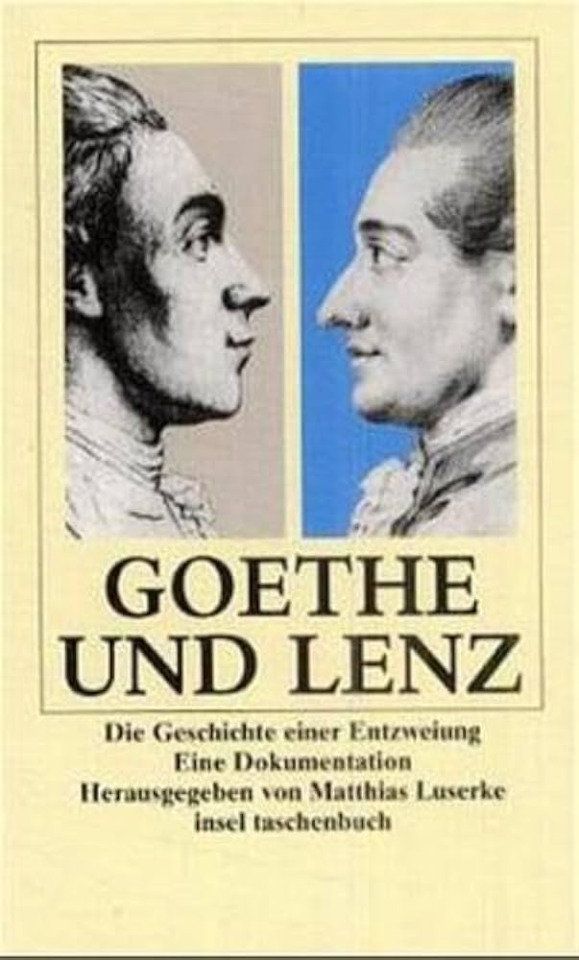
1751 – On this date the Baltic German writer of the Sturm und Drang movement Jakob Lenz was born (d.1792). Lenz is remembered as the most creative and original of Goethe's Strasbourg friends and, because of failures in his personal life, as a figure of pathos. The son of a Lutheran pastor who received a theological education at the University of Koenigsberg, Lenz was a religious thinker who saw himself as prophet as well as poet.
In 1771 in Strasbourg, he met the young Johann Wolfgang von Goethe, who at this time happened to be in Strasbourg, and whose acquaintance Lenz made, as well as that of Johann Heinrich Jung-Stilling. Goethe now became Lenz's literary idol, and through him he made contact with Johann Gottfried Herder and Johann Kaspar Lavater, with whom he corresponded.
In the following year, 1772, Lenz accompanied his literary masters to the garrisons of Landau, Fort Louis and Wissembourg. He also fell in love with Friederike Brion, once the beloved of Goethe, but his feelings were not reciprocated.
Recent scholarship has has revealed Lenz's relationship with Goethe. In books like Karl Hugo Pruys' "The Tiger's Tender Touch: The Erotic Life of Goethe" and Alice Kuzniar's "Outing Goethe and His Age" Lenz's full character and sexuality has been revived. Lenz was deeply in love with Goethe. Indeed he wrote countless love letters to the writer in which he professed his desire to be Goethe's wife.
Historians of Goethe have always been puzzled by an incident in Goethe's life. In April 1776 Lenz followed Goethe to the court of Weimar where he was at first amicably received. But in early December, on Goethe's instigation, he was expelled. The exact circumstances are not recorded; Goethe, who broke off all personal contact with him after this, refers only vaguely in his diary to "Lenz's idiocy" ("Lenzens Eseley"). Historians seem puzzled by this strange rejection of Lenz. A clearer reading of their relationship or Lenz's desires for Goethe make the situation a bit more clear. The rejection may have been a break in their relationship or a spurning of Lenz's attentions.

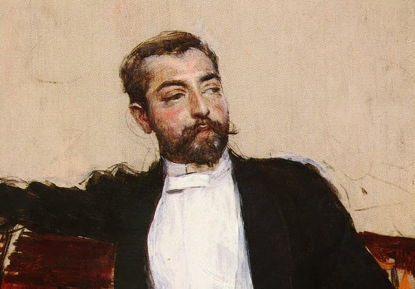
1856 – John Singer Sargent American portrait painter, born (d.1925) was the most successful portrait painter of his era, as well as a gifted landscape painter and watercolorist. Sargent was born in Florence, Italy to American parents. He studied in Italy and Germany, and then in Paris under Emile Auguste Carolus-Duran. Among the artists with whom Sargent associated were Dennis Miller Bunker, Carroll Beckwith, Edwin Austin Abbey (who also worked on the Boston Public Library murals), Francis David Millet, Wilfrid de Glehn, Jane Emmet de Glehn and Claude Monet, whom Sargent painted.
He developed a life-long friendship with fellow painter Paul César Helleu, whom he met in Paris in 1878 when Sargent was twenty-two and Helleu was eighteen. Sargent painted both Helleu and his wife Alice on several occasions, most memorably in the impressionistic Paul Helleu Sketching with his Wife, 1889. His supporters included Henry James, Isabella Steward Gardner, (who commissioned and purchased works from Sargent and sought his advice on other acquisitions) and Edward VII, whose recommendation for knighthood the artist declined.
Sargent was, as they say, "extremely private regarding his personal life," though the painter Jacques-Émile Blanche, who was one of his early sitters, said — after his death — that Sargent's sex life "was notorious in Paris, and in Venice, positively scandalous. He was a frenzied bugger." Was the bugger refernce as in "buggery"?. As homophobic scholars put it, "the truth of this may never be established." Some have gone so far as to boldly suggest that Sargent was homosexual. He had personal associations with Prince Edmond de Polignac and Count Robert de Montesquiou (the model for Des Esseintes in Huysman's A Rebours, and even more famously, the Baron de Charlus in Proust's A la recherche du temps perdu, and, in real life, if you will, Prince Polignac's life-long lover, as well), two of the most notorious homosexuals of the age.
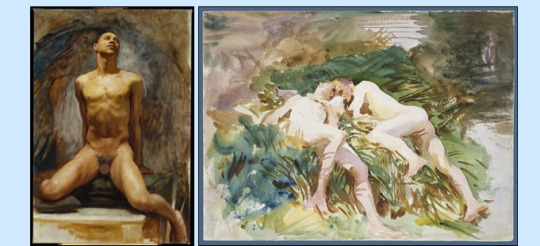
Sargent's male nudes reveal complex and well-considered artistic sensibilities about the male physique and sensuality; particularly evident in his portrait of Thomas E. McKeller but also in Tommies Bathing (both above), nude sketches for Hell and Judgement, and his portraits of young men, like Bartholomy Maganosco and Head of Olimpio Fusco .
There were friendships with women, as well, and a similar sensualism informs his female portrait and figure studies (notably Egyptian Girl, 1891). The likelihood of an affair with Louise Burkhardt, the model for Lady with the Rose, and the first wife of author J.R. Ackerley's father is accepted by Sargent scholars. Sargent's friends went so far as to wonder if he and Burckhardt had formed a romantic attachment. His enthusiasm while creating the picture of her probably instigated the rumors, but a mutual friend learns from Sargent in 1882 that "he does not care a straw for her." Despite numerous friendships with women throughout his life, this is the only episode to cause associates to doubt his status as a "committed bachelor." His sensuous, unparalleled appreciation of male beauty leaps off the canvas to this day.


1941 – On this date the pioneering British bluesman Long John Baldry was born (d.2005). Born John William Baldry in England, he grew to 6' 7" which resulted in the nickname "Long" John. Gifted with a deep, rich voice, he was one of the first British vocalists to sing blues in clubs.
In the early 1960s, he sang with the seminal band, Alexis Korner's Blues Incorporated, with whom he recorded the first British blues album in 1962, "R&B at the Marquee." At stages, future Rolling Stones members Mick Jagger, Charlie Watts, Keith Richards and Brian Jones played in the band. The Rolling Stones supported Baldry in their first concert at the Marquee Club. Later, Baldry was the announcer introducing The Stones on their US-only live album, "Got Live if You Want It!," in 1966.
Baldry became friends with Paul McCartney after a show at the Cavern Club in Liverpool in the early 1960s, leading to an invitation to play on one of The Beatles 1964 TV specials. In 1963, Baldry joined the Cyril Davies R&B All Stars with Jimmy Page on guitar and Nicky Hopkins playing piano. He took over in 1964 after the death of Cyril Davies. It became Long John Baldry and his Hoochie Coochie Men featuring Rod Stewart on vocals and Geoff Bradford on guitar. Stewart was recruited after Baldry heard him busking a Muddy Waters song at Twickenham station after Stewart had been to a gig at Eel Pie Island.
In 1965, the Hoochie Coochie Men became Steampacket with Baldry and Stewart as male vocalists, Julie Driscoll as the female vocalist and Brian Auger on Hammond organ. After Steampacket broke up in 1966, Baldry formed Bluesology featuring Reg Dwight on keyboards and Elton Dean, later of Soft Machine, as well as Caleb Quaye on guitar. Dwight adopted the name "Elton John" (taking his first name from another member of the band, Elton Dean, and his surname from Baldry).
In 1967, he recorded a pop song "Let the Heartaches Begin" that went to number one in Britain, followed by a 1968 top 20 hit titled "Mexico", which was the theme of the UK Olympic team that year. "Let the Heartaches Begin" made the lower reaches of the Billboard Hot 100 in the US.

Baldry was openly gay during the early 1960s when homosexuality was still criminalised and medicalised. Baldry supported Elton John in coming to terms with his own sexuality. In 1978 his album Baldry's Out announced his formal coming out, and he addressed sexuality issues on A Thrill's a Thrill, a song on the LP.
Bluesology broke up in 1968, with Baldry continuing his solo career and John forming a songwriting partnership with Bernie Taupin. In 1969, Elton John tried to commit suicide after relationship problems with a woman. Taupin and Baldry, who was by now openly Gay, found him, and Baldry talked him out of marrying the woman, helping make John comfortable with his sexuality. The song "Someone Saved My Life Tonight" from "Captain Fantastic and the Brown Dirt Cowboy" was about the experience.
In 1971, Elton John and Stewart each produced one side of "It Ain't Easy" which became Baldry's most popular album and made the top 100 of the US album charts. The album featured "Don't Try to Lay No Boogie Woogie on the King of Rock and Roll" which became his most successful song in the US. John's first tour of the US was this time. Baldry's 1972 album "Everything Stops For Tea" made the lower reaches of the US album charts.
After time in New York City and Los Angeles in 1978, Baldry settled in Vancouver, British Columbia, where he became Canadian. He toured the west coast, as well as the U.S. Northwest. Baldry also toured the Canadian east, including one 1985 show in Kingston, Ontario, where audience members repeatedly called for the title track from his 1979 album "Baldry's Out!" - to which he replied, "I'll say he is!"
He played his last live show in Columbus, Ohio, on July 19, 2004.


1951 – Mark Segal is an American journalist. He participated in the Stonewall riots and was one of the original founders of the Gay Liberation Front where he created its Gay Youth program. He was the founder and former president of the National Gay Newspaper Guild and the founder and publisher of Philadelphia Gay News. He has won numerous journalism awards for his column "Mark my Works."
Segal was a participant at Stonewall in 1969 and help found the Gay Liberation Front that same year. He was also a member of The Christopher Street Gay Liberation Day committee, which organized the first Gay Pride parade in 1970.
In 1972, after being thrown out of dance competition for dancing with a male lover, Segal crashed the evening news broadcast of WPVI-TV, an act that became known as a "zap" and that he helped popularize. He repeated the action during many other television broadcasts.
In 1975, he went on a hunger strike on behalf of the passage of a law to guarantee equal rights for homosexuals. In 1976, he founded the Philadelphia Gay News, a lesbian, gay, bisexual and transgender (LGBT) newspaper in the Philadelphia area. The publication was inspired by activist Frank Kameny, whom Segal first met in 1970. In 1988, Segal had a televised debate with a Philadelphia city councilman, Francis Rafferty, about Gay Pride Month.
Segal partnered with the Obama Administration to create and build the nation's first official “LGBT Friendly” Senior Affordable housing apartment building. The 19.8 million dollar project known as The John C. Anderson Apartments opened in 2013.
Segal is Jewish and originally from Mount Airy, Philadelphia. He attended school at Germantown High School and Temple University. His friends include several prominent gay activists like Barbara Gittings, Frank Kameny, Harry Hay and Troy Perry.
On July 5, 2014, Segal married his partner of 10 years, Jason Villemez. At the time, Villemez was 29 and Segal was 63. The ceremony was officiated by Judge Dan Anders, Philadelphia’s first openly gay judge.


1954 – Today is the birthday of Felipe Rose, better known as "the Indian guy from The Village People." He was born in New York and grew up in Brooklyn. He's part American Indian (Lakota) and part Puerto-Rican (on his mother's side). He actually studied dance with the Ballet de Puerto Rico and was later discovered by the music producer Jacques Morali while working as a bartender and dancing in a New York gay club and recruited for a new disco group he was forming.
While the producers were busy recruiting and preparing the other members of the group, Rose was sent to Paris where he choreographed a native dance number for the Crazy Horse Saloon. When he returned to the U.S., he suggested that the other members of the group wear uniforms representing different "manly" occupations in New York's Greenwich Village.The rest as they say is history. His hits with the Village People hits include Macho Man (1978), YMCA (1978), In The Navy (1979), Go West (1979), Can't Stop the Music (1980)
In 2000, Rose began to work on his solo career. His single "Trails of Tears" was nominated for 3 Native American Music Awards for Best Historical Recording, Song of the Year and Best Producer. In 2002, Rose was the opening act of the 5th Annual Native American Music Awards and won a NAMMY Award for the Best Historical Recording.
In 2005 Rose called up the Smithsonian National Museum of the American Indian in Washington, DC to offer them his framed gold record for the disco group's 1978 megahit "Y.M.C.A." The staff of the new museum had never received such a call but were delighted to accept the items into their collection. The Washington Post's writer Hank Stuever opined that the museum accepted the record "on the precept that sooner or later they might need such an artifact of a bygone era, perhaps to flesh out a future exhibit on the folkloric value of disco, and native cultural responses to it."


1973 – Joel Derfner is an American writer and composer. He is the author of three gay-themed books: Gay Haiku (2005), Swish: My Quest to Become the Gayest Person Ever and What Ended Up Happening Instead (2008), and Lawfully Wedded Husband: How My Gay Marriage Will Save the American Family (2013). His articles have appeared in publications including the Huffington Post, The Advocate, Time Out New York, and Between the Lines. Derfner and his works have been cited as references on gay culture, and he has been noted as one of "today's best-known gay writers".
He is the composer of several musicals, and he teaches musical theater composition at New York University’s Tisch School of the Arts. Derfner was also co-star of the first season of the 2010 reality television show Girls Who Like Boys Who Like Boys, along with his close friend Sarah Rose.
Derfner was born in 1973 in Washington, D.C. and grew up in Charleston, South Carolina. His parents were civil rights activists, and were active in Mississippi during the Civil Rights Movement. His father, Armand Derfner, is a civil rights lawyer, and his mother Mary Frances Derfner (née Seddon) met Armand when she became his legal secretary in Washington, D.C. in 1967. Joel's father is Jewish and his mother was Christian; he was raised Jewish and converted to Judaism at the age of seven His mother, who suffered from type 1 diabetes, died in 1992. Joel came out to his parents as gay when he was 15.
Derfner lives in New York City with his husband, Mike Combs, a psychiatrist who runs an inpatient unit at a New York City psychiatric hospital. He and Combs became engaged in 2007.[88] The couple were legally married in Iowa in May 2010 and had their formal wedding ceremony in October 2010 in Brooklyn Botanic Garden.


1974 – Chinese Gay Rights Pioneer,GLBT activist and attorney Zhou Dan came out to his friends in 1998 and the media in 2003. A champion of GLBT rights in China, Zhou writes articles on Chinese gay and lesbian Web sites. Although many GLBT Chinese use pseudonyms, Zhou uses his real name. After revealing his sexuality to a Shanghai newspaper in 2003, Zhou appeared across China in newspapers and magazines and on television. Earlier that year, he established the Shanghai Hotline for Sexual Minorities.
One generation removed from the persecution of gays under the People's Republic of China, Chinese gays encounter different obstacles than their American counterparts. Many Chinese believe that homosexuality exists only in the western world. The absence of legal protection and the threat of social isolation keep most Chinese GLBT individuals in the closet.
Zhou also fights for rights of people living with or affected by HIV/AIDS in China, by advocating a human-rights-based approach to the epidemic.
In 2004, Zhou attended Yale Law School's China Law Center as a visiting scholar. In 2006, he taught China's first graduate class on homosexuality at Fudan University in Shanghai.


1986 – Kieron Richardson, born in Eccles, Greater Manchester, England, is an English actor and Presenter best known for playing the role of Ste Hay in Hollyoaks.
After appearing briefly in the late night Hollyoaks: In the City, Richardson was offered the role of Ste Hay in the early evening Hollyoaks where he appeared for 19 episodes. The character was written out of the show after stealing a car, which resulted in a spectacular crash and his character getting sent to prison. He returned to Hollyoaks on 25 September 2007, and has been a regular cast member since.
Richardson has also made appearances in Holby City, Heartbeat and the feature film Fragments, as well as the pantomime Cinderella as Prince Charming at The Embassy Theatre, Skegness in 2006.
Richardson took part in 2010 series of ITV's Dancing on Ice and was paired with series newcomer Brianne Delcourt. He reached the final, finishing in third place.
In 2011, Richardson and his Hollyoaks ex co-star Bronagh Waugh started presenting on radio station Gaydio.
On 15 September 2010, Richardson revealed on television programme This Morning that he is gay, and accepted it at the age of 20. He was inspired to come out by X Factor winner Joe McElderry. In July 2014, Richardson received a torrent of homophobic abuse via social networking site Twitter. That month Richardson announced his intention to marry long-term partner Carl Hyland the following year. In April 2015, the couple were married in a star-studded ceremony in the Peak District.
In December 2016, Richardson announced they were expecting twins via surrogacy. They have twins born in 2017, a boy and girl.


2009 – On this date a landmark of sorts occurred on American daytime television when after months of teasing and steamy kisses, the soap opera As The World Turns featured the boyfriends Luke and Noah finally having sex in a breakthrough episode for daytime television.


2012 – A firestorm was set off by the revelation that a Canadian government lawyer had filed a document in a divorce case stating that same-sex marriages entered into by foreign couples who reside in jurisdictions that do not recognize same-sex marriage are not valid in Canada.
The statement was at first widely regarded as an attempt to undermine same-sex marriage by the Conservative government of Prime Minister Stephen Harper. After the legal brief had been denounced roundly both in Canada and abroad, the government announced that it had no intention of reopening the question of same-sex marriage and that it recognized as valid the same-sex marriages of foreign nationals.


13 notes
·
View notes
Text
Food Options for People with Histamine and Salicylate Itolerances
Hi All,
My wife just found out that she has both histamine intolerance and salicylate intolerance. Within days of starting to take antihistamines and eating only very low histamine/salicylate foods, nearly every health problem she's had for the last 15 years (including vision problems, plantar fasciitis, severe GERD, severe brain fog (to the point where we thought she had early onset Alzheimer's), chronic fatigue, and joint pain) literally went away or got markedly better overnight.
The only thing is: If you're really strict on the low histamine and low salicylate diets, it really limits what you can eat. If you're gluten or lactose intolerant as well, that makes things even more difficult.
So I decided to put together some recipes that contain the lowest possible histamine and salicylate burdens. The "safest" list contains only the following: Bamboo shoots, cabbage, celery, iceberg lettuce, peeled white potato, millet, oats, rice, maple syrup, white sugar, distilled white vinegar, saffron, sea salt, canola oil, safflower oil, egg yolk, meat, fish, poultry- very fresh only, true fish only.
Marinade: Mince a stalk of celery, then combine that with a third of a cup white vinegar, a half teaspoon salt, and 2 tbsp maple syrup. Soak your meat or poultry in it before cooking to give it some flavor.
Salad (or anything) Dressing: Whisk together 2 raw egg yolks, 2 tbsp white vinegar, and 2 tbsp canola oil. Salt to taste.
Slaw: Shred a quarter of a cabbage, 3 stalks celery, and 1 can bamboo shoots. Toss in a dressing made from a third of a cup of white vinegar, a tbsp white sugar, and a third of a cup of canola or safflower oil.
Potato and Rice fritters: Cook a cup of white rice until it's soft. Peel and chop a medium potato into 1-in cubes, boil potato until soft, drain and mash. Mix rice and potato, add 2 egg yolks and salt to taste, form into patties, and fry in canola oil.
Potato and Celery Soup: Mince 5 stalks of celery and fry in a tbsp or two of canola oil. Add 4 cups chicken stock (make ahead by boiling a chicken carcass in water with a tbsp vinegar for 3 hours) and 2 large potatoes (peeled and cubed). Boil until the potatoes are soft. Mash the potatoes in the stock, add salt to taste, and serve.
Congee with Pickle: Soak bamboo shoots overnight (or a few hours) in a mixture of 1/3 cup vinegar, a teaspoon salt, and a tbsp sugar. Make a rice or millet soup by cooking grains in about double the water specified on the package. Mash the grain and flavor this soup with salt or sugar to taste. Fry a couple of egg yolks or some fish and place on top. Eat with your bamboo shoot pickle.
Millet Crispies: Pop millet by placing a small amount in a dry frying pan.
Oatmeal: Make oatmeal according to package instructions with salt to taste. Top with fried egg yolks, maple syrup, millet crispies, fried minced celery, slaw, or whatever meat options you have available.
Celery Boats: Shred a cup or so of cooked chicken and toss with salad dressing listed above. Fill stalks of celery with the mixture.
Beef and Cabbage Soup: Fry 3 stalks of minced celery in canola oil at the bottom of a pot. Cut up a half head of cabbage into ribbons and fry with the celery. Remove the celery and cabbage. Put a pound of beef stew meat cut into 1-in chunks (or ground meat of choice) in the pot and brown. Add the celery and cabbage back in, add 6 cups water or stock, and boil with salt to taste until at least the meat is cooked through, about 20 minutes.
Lettuce wraps: Brown a pound of ground chicken in a pan with 3 stalks minced celery, half a cup of chopped bamboo shoots, a tbsp of vinegar and salt to taste. When cooked through, carefully remove leaves of iceberg lettuce from a head. Fill with meat mixture and enjoy. Serve with rice.
Rice Pudding: Whisk together 4 egg yolks, a quarter cup maple syrup, 2 tbsp glutinous rice flour, a pinch of salt, and a scant cup of water. Add this to a pot with 1.5 cups COOKED rice. Stir on medium heat until the rice has absorbed most of the liquid but is still somewhat pour-able. Pour into a small casserole type dish and chill in the fridge to set.
Contains wheat, fresh dairy, onion, parsley:
Beef Stew: Cook 4 stalks minced celery and 1 minced medium onion in butter or ghee until soft. Add 1 lb beef stew meat cut into 1-in chunks and brown. Add 6 cups stock or water and salt and parsley to taste. Whisk together 1/2 cup water and 1/2 cup flour and add to mixture. Peel and cut 2 medium white potatoes and add to mixture. Bring to a low boil and simmer until meat and potato chunks are cooked through- about 20 minutes.
Flat breads: Combine 3/4 cup water and 1/4 cup butter, oil, or ghee with 2 cups flour (adjust amounts as needed to create a workable dough). Roll into flat rounds and cook on a dry skillet.
Mashed Potatoes with Onion: Peel and cut 4 large white potatoes into 1-in cubes. Place in a pot with water to cover. Boil for 20-30 minutes. While boiling, mince 1 large white onion and cook in butter, oil, or ghee until caramelized. Drain and mash potatoes. Add onion to potatoes along with a tbsp dried parsley and salt to taste and cream or milk to taste. Stir everything together.
Deep Fried Cheese Curds, Chicken Nuggets, Battered French Fries, or Onion rings: Combine 1 cup milk, 1 cup flour, 1 tbsp onion powder, 1tsp baking soda, and salt to taste. Bring 2-3 inches of canola oil or lard to frying temp. Dump 1lb of cheese curds, 1-in flattened chunks of chicken, sliced white potato, or sliced onion in batter, and spoon them into the frying oil. Fry until crispy and remove onto a plate lined with paper towels. See "Salad Dressing" in previous comment for something to dip in.
Maple Milk: Put a few tbsp maple syrup into a glass of warm or cold milk for a treat.
Cheesy Dessert Tacos: Make flatbreads listed above. Mix together 2 tbsp maple syrup with a half cup plain farmer's cheese or goat cheese. Spread on flat breads and fold like a taco.
Cheesy Dinner Tacos: Combine 2 tsp onion powder and 2 tsp dried parsley with a half cup plain farmer's or goat cheese. Spread on flatbreads. Add shredded cooked chicken and shredded cabbage. Fold like a taco.
Mapley "Crime" Brulee: Whisk together 6 egg yolks, 4 tbsp maple syrup, and 2.5 cups heavy whipping cream in a pot over low heat, whisking continuously until thick. Pour into ramekins, sprinkle with white sugar, bake until set, then broil until the tops are crispy.
153 notes
·
View notes